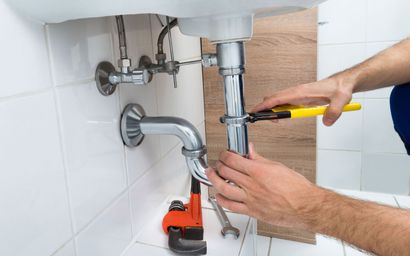The author is making several good points about Plumbing Installation 101: All You Need to Know overall in the article below.

Understanding exactly how your home's pipes system works is necessary for every home owner. From providing clean water for drinking, food preparation, and showering to safely eliminating wastewater, a well-maintained plumbing system is essential for your family members's health and comfort. In this comprehensive overview, we'll discover the intricate network that makes up your home's pipes and offer pointers on maintenance, upgrades, and managing usual issues.
Intro
Your home's pipes system is more than just a network of pipelines; it's a complex system that ensures you have access to clean water and efficient wastewater elimination. Understanding its components and exactly how they interact can help you protect against costly fixings and ensure everything runs smoothly.
Fundamental Parts of a Pipes System
Pipelines and Tubes
At the heart of your pipes system are the pipelines and tubes that carry water throughout your home. These can be made of different materials such as copper, PVC, or PEX, each with its advantages in terms of toughness and cost-effectiveness.
Components: Sinks, Toilets, Showers, etc.
Components like sinks, bathrooms, showers, and tubs are where water is made use of in your house. Recognizing just how these components connect to the pipes system aids in detecting troubles and intending upgrades.
Shutoffs and Shut-off Factors
Shutoffs regulate the circulation of water in your plumbing system. Shut-off valves are important during emergencies or when you need to make repair services, allowing you to separate parts of the system without disrupting water circulation to the whole home.
Supply Of Water System
Main Water Line
The main water line connects your home to the metropolitan water or an exclusive well. It's where water enters your home and is dispersed to numerous components.
Water Meter and Pressure Regulator
The water meter actions your water use, while a pressure regulator ensures that water flows at a secure stress throughout your home's plumbing system, preventing damages to pipes and fixtures.
Cold Water vs. Hot Water Lines
Understanding the difference between cold water lines, which supply water straight from the major, and warm water lines, which bring warmed water from the water heater, assists in fixing and planning for upgrades.
Water drainage System
Drain Pipeline and Traps
Drain pipes lug wastewater away from sinks, showers, and bathrooms to the sewer or septic tank. Catches prevent sewer gases from entering your home and also catch debris that could create blockages.
Air flow Pipelines
Air flow pipes permit air right into the drainage system, protecting against suction that could slow down drain and create catches to empty. Correct air flow is important for maintaining the stability of your pipes system.
Significance of Correct Drain
Guaranteeing proper drainage stops backups and water damages. On a regular basis cleaning up drains pipes and maintaining catches can prevent costly fixings and expand the life of your pipes system.
Water Heating Unit
Types of Water Heaters
Hot water heater can be tankless or standard tank-style. Tankless heating systems warm water on demand, while containers keep warmed water for immediate use.
Updating Your Pipes System
Reasons for Upgrading
Upgrading to water-efficient fixtures or replacing old pipelines can enhance water high quality, minimize water costs, and increase the worth of your home.
Modern Pipes Technologies and Their Benefits
Check out modern technologies like clever leakage detectors, water-saving commodes, and energy-efficient hot water heater that can save money and decrease ecological influence.
Price Factors To Consider and ROI
Calculate the upfront expenses versus long-lasting financial savings when taking into consideration plumbing upgrades. Numerous upgrades spend for themselves via lowered energy costs and fewer repairs.
How Water Heaters Attach to the Pipes System
Recognizing just how hot water heater attach to both the cold water supply and warm water circulation lines aids in diagnosing issues like inadequate hot water or leaks.
Maintenance Tips for Water Heaters
Frequently purging your hot water heater to get rid of debris, examining the temperature level settings, and examining for leakages can prolong its life expectancy and enhance energy efficiency.
Common Pipes Concerns
Leaks and Their Causes
Leaks can occur due to aging pipes, loosened fittings, or high water pressure. Dealing with leaks promptly prevents water damages and mold and mildew growth.
Obstructions and Obstructions
Blockages in drains pipes and bathrooms are frequently caused by purging non-flushable things or a buildup of oil and hair. Making use of drain screens and bearing in mind what drops your drains can prevent blockages.
Indicators of Plumbing Problems to Expect
Low water pressure, slow-moving drains pipes, foul odors, or uncommonly high water bills are indicators of prospective pipes troubles that must be attended to promptly.
Pipes Upkeep Tips
Regular Examinations and Checks
Arrange annual pipes examinations to catch issues early. Try to find signs of leakages, rust, or mineral build-up in faucets and showerheads.
DIY Upkeep Tasks
Easy jobs like cleaning tap aerators, checking for bathroom leakages utilizing dye tablets, or shielding revealed pipes in cold environments can stop major pipes issues.
When to Call an Expert Plumber
Know when a pipes problem calls for professional expertise. Trying intricate repair work without correct knowledge can lead to even more damages and higher repair service costs.
Tips for Minimizing Water Use
Easy practices like fixing leakages promptly, taking shorter showers, and running complete loads of laundry and meals can conserve water and lower your energy expenses.
Eco-Friendly Pipes Options
Take into consideration lasting pipes materials like bamboo for floor covering, which is durable and green, or recycled glass for counter tops.
Emergency Readiness
Actions to Take Throughout a Pipes Emergency situation
Know where your shut-off shutoffs are located and just how to turn off the water supply in case of a burst pipeline or major leakage.
Relevance of Having Emergency Situation Contacts Convenient
Keep call info for local plumbers or emergency solutions conveniently available for quick feedback throughout a pipes situation.
Environmental Impact and Conservation
Water-Saving Fixtures and Home Appliances
Setting up low-flow taps, showerheads, and toilets can dramatically reduce water usage without compromising efficiency.
DIY Emergency Situation Fixes (When Relevant).
Temporary repairs like utilizing air duct tape to patch a leaking pipe or putting a bucket under a dripping tap can minimize damage till a professional plumbing technician arrives.
Final thought.
Comprehending the anatomy of your home's plumbing system encourages you to keep it properly, conserving money and time on fixings. By adhering to normal maintenance routines and staying educated regarding modern-day pipes innovations, you can ensure your pipes system runs effectively for years to come.
How Should a Plumbing System Be Designed?
What's A Decent Plumbing Design?
A home's mechanical, electrical, and plumbing systems must be carefully considered throughout any construction or renovation projects, whether undertaken from the ground up or reworking existing rooms.
All three go hand in hand, and trained engineers or architects may design effective plumbing system plans. Plumbing problems might arise if the architects and builders who worked on your property neglected to include essential components of good plumbing design.
What Makes Plumbing Plans For Houses So Crucial?
Domestic buildings often have an intricate system of plumbing pipes running throughout the structure. It would help if you thus had a well-thought-out strategy before beginning construction on your new home.
According to teamemergencyplumber.com, a well-drawn plumbing plan for a home will show how the water and sewage systems work together. The MEP installations, of which plumbing systems are a component, contribute to the "creature comforts" of the building and are highly interactive with one another.
Successful Home Plumbing Design
The primary neurological system of every building is its plumbing system. Hence engineers and architects must work together to design it.
Main Building Codes
The plumbing system layout for a home must adhere to all applicable local construction requirements. The number of fixtures permitted on a given drain system, vent stack, the location of supply drains, and lines are all specified by the relevant building regulations.
It is important to have a well-designed plumbing system that complies with all applicable regulations. It is built with meticulous attention to detail so that it may pass muster during building inspections and adhere to all applicable rules and regulations.
Draft Of Supply
These blueprints calculate the approximate lengths and placements of hot and cold water supply lines. The package includes a variety of blueprints, as well as details on water, drain, and vent lines, as well as installation guidelines, legends, and explanatory comments.
Still, the plans don't always account for the fact that the pipes' precise placement may depend on the specifics of each building. Fixture placement, dimensions, the minimum height from the floor, distance from the wall, symbols, and other information are typically included in rough-in plumbing.
Gas Piping
Natural gas and propane appliances may be installed in nearly all homes. Fuel for the stove, oven, furnace, etc., is piped through iron, polyethylene, and steel pipes. Lines are combined using threaded fittings that screw together and are sealed at the joint the seal functions as a protective barrier to keep harmful substances out.
Heightening of the DWV
The system that transports the wastewater and air out of the home is called a Drain-Waste-Vent elevation, or DWV for short. This section addresses the direction that exhaust vents, drain pipes, and traps in plumbing fixtures all point upward. Primarily, it demonstrates how various fixtures' airflow will work. A reference drawing doesn't have to be made directly on top of architectural plans.
Pipes of the Appropriate Dimensions
Pipes must be properly sized to prevent future obstructions and costly repairs. Undersized pipes will prevent the system from working properly and will not fulfill plumbing standards.
Inadequate water pressure from the pipes or inconsistent water temperatures between fixture models is possible issues. Similarly crucial is selecting an appropriate pipe type. PVC pipes are widely used, but they break easily and must be replaced more often than stronger materials like copper or PEX after they're installed in a home.
The efficiency of the plumbing system and the reduction in future maintenance efforts are directly related to the material and size of the pipes.
Access to Water
Engineers and architects must provide workable solutions that propose a contaminant-free, continuous water supply at all times by preventing the connection of freshwater.
In addition, the concept allows for the water supply and DWV systems to be located close to one another, resulting in a hot water loop that helps save water and energy expenditures. Likewise, appropriate water flow is maintained by ensuring water can get from the reservoir to your home.
Electric water pumps in water supply systems enhance efficiency by facilitating seamless water circulation. Strategically placed pumps optimize water flow, reaching every part of the distribution network. To choose an electric water pump, assess your specific requirements, such as flow rate and pressure needs for residential or industrial use. Confirm that the pump's power specifications align with your electrical supply.
Select the appropriate type of pump, considering options like centrifugal or submersible based on your application. Factor in size, portability, and material construction, ensuring corrosion resistance for challenging environments. Evaluate maintenance accessibility and prioritize energy efficiency, considering variable speed options or pumps meeting efficiency standards. Check out Generator Pro to learn how electric pumps work.
Outdoors
The plumbing layout also shows where to attach the outside sinks. Depending on the layout of your home, you may have several outdoor water sources that all work together. However, your engineer or architect can help you determine what fittings will be required.
The plan can also include a water sprinkler system, an in-ground swimming pool, a hot tub, an outdoor kitchen, and a septic tank if necessary. If you ever decide to put your house up for sale, this sort of outside connection is sure to be a big plus.
https://amazingarchitecture.com/articles/how-should-a-plumbing-system-be-designed

As a serious person who reads on Anatomy of a House: Understanding the Components, I figured sharing that excerpt was important. Those who appreciated our page kindly be sure to share it. Thanks for being here. Revisit us soon.
Book Maintenance
 Kelly McGillis Then & Now!
Kelly McGillis Then & Now! Michael Bower Then & Now!
Michael Bower Then & Now! Tahj Mowry Then & Now!
Tahj Mowry Then & Now! Ashley Johnson Then & Now!
Ashley Johnson Then & Now! Brooke Shields Then & Now!
Brooke Shields Then & Now!